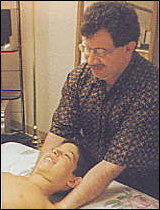
The following is the text of an article written by my dear friend Raymond J. Bishop. Ray did his basic Rolfing® training and his Rolf™ Movement training at the Rolf Institute for Structural Integration in 1995. He did his advanced Rolfing® training with Jan Sultan and Sally Klemm in Seattle in 2000. Ray has a Ph.D. in musicology from UNC-Chapel Hill and has published numerous articles on bodywork and music, somatic metaphor, anatomy, and structural integration history and theory. Ray passed away in December 2008 and I reprint this article here with the permission of his life partner, Carlton.
The notion of the practice of bodywork as a meditative discipline may at first seem rather peculiar. Certainly, many seasoned bodyworkers meditate, rightly believing that regular practice of any of a wealth of meditative modalities will promote an increased sense of mental clarity and calmness, and may potentially enhance the experience of everyday life as well as the quality and depth of their work. However, accepting the idea that the act of doing integrative bodywork can be both the source of meditative insight and an ideal milieu through which we move towards higher levels of consciousness will for most require a shift in paradigm of a fairly high order. This perceptual difficulty will be further magnified when applied to those therapists engaged in disciplines that are thought of as intense and whose work is generally described as deep tissue manipulation, work such as the style of structural integration called Rolfing®. That such a modality offers a gateway to “the meditative” will at first seem contradictory in the extreme owing to a number of fundamental misapprehensions about the nature and intent of this and related integrative modalities. Furthermore, the idea that those who do bodywork may choose to do so in part as a selfish desire to attain an altered mental state may seem curiously at odds with the altruism which we associate with those drawn to healing touch modalities. Yet, we will argue for the virtues of this type of selfishness (Ayn Rand, notwithstanding).
Any effort to advance arguments such as those addressed here must suffer from the proliferating misperceptions of integrative bodywork as well as from the ever-present fear that such an argument will lapse into a New Age double-speak, a nebulous metaphysical languaging, which, once introduced, would inevitably weaken our argument’s credibility among those more technically minded. Despite all these potential pitfalls, this is precisely what we will attempt. Our approach is two-fold. The first prong of this sharply taloned yet gentle beast is to clarify the nature of the work through which we hope to attain this meditative state (the medium being much more than the massage) and the second is to suggest some reasons why such a relationship is not only possible but virtually inevitable once we approach the work with the proper mindset.
* * * *
Most would agree that the vast majority of bodywork systems are about treating symptoms and alleviating pain. The means employed to accomplish these goals are rich and diverse. To narrow the  scope of our discussion, therefore, we will look at a few elements of the style with which the author has the most familiarity, that being Rolfing. Rolfing is a copywritten term for a specific approach to Dr. Ida Rolf’s method that she called structural integration (SI). This approach has many detractors and proponents, yet has influenced a spate of related disciplines that, to varying degrees, succeed in their ability to create and describe order, often reproducing excellent recreations of what Dr. Rolf meant by a properly integrated body. Seeing and articulating order in the sense that Dr. Rolf saw it has proven quite difficult to recreate and even harder to describe, although some have recently done a commendable job of presenting her ideas and expressing with clarity and persuasiveness many of the criteria used by Rolfers and other SI practitioners in evaluating and quantifying the degree of order (hence, integration) in an individual’s system.¹
scope of our discussion, therefore, we will look at a few elements of the style with which the author has the most familiarity, that being Rolfing. Rolfing is a copywritten term for a specific approach to Dr. Ida Rolf’s method that she called structural integration (SI). This approach has many detractors and proponents, yet has influenced a spate of related disciplines that, to varying degrees, succeed in their ability to create and describe order, often reproducing excellent recreations of what Dr. Rolf meant by a properly integrated body. Seeing and articulating order in the sense that Dr. Rolf saw it has proven quite difficult to recreate and even harder to describe, although some have recently done a commendable job of presenting her ideas and expressing with clarity and persuasiveness many of the criteria used by Rolfers and other SI practitioners in evaluating and quantifying the degree of order (hence, integration) in an individual’s system.¹
Our goal here is not to engage in hairsplitting distinctions between the several methods of SI currently practiced. We leave that labyrinthine task to others while praising the recently created umbrella organization, the IASI, the International Association of Structural Integrators, in its efforts to reconcile these diverse permutations of Dr. Rolf’s work.² Rather, we will look at some of the elements of properly executed and well-informed structural integration and how this approach acts as a necessary prelude to working in a meditative manner.
Let’s first consider fascia, that vital network of interwoven connective tissue layers, and the notion that Rolfing is fascial work. One seldom-explained misconception is that the common view that Rolfing is fascial work pure and simple is misleading. The fallacy of this argument is obvious to anyone who has worked with connective tissue. There are multiple layers of such tissue, with clear names and distinct characteristics but no clear boundaries. These layers are not as discrete as the layers of sediment at an archeological site but more like the innards of an orange with juicy rich segments and interrelationships that are potentially altered by even the gentlest pressure.³
Obviously, we work on all layers of connective tissue from the surface to the bone. We address epidermis and other dermal layers, the adipose and then access numerous fascial layers down to the fascia profundus. We work on, around and in between muscles, deep into their septa, and follow them into their tendonous attachments, through those intrinsic ligamentous structures, feeling our way into the periosteum, easing adhesions along the major osseous strucures, also effecting change in the connective tissue surrounding organs and neurovascular structures. We might more properly say that fascia is the medium through which we work as we alter relationships between myofascial, osseous and visceral structures.?
Notes
1. Among the many recent books on the subject, the curious reader might consult: Heller, Joseph & Henkin, William A., Bodywise: Regaining Your Natural Flexibility and Vitality for Maximum Well-Being (Oakland, CA: Wingbow, 1995); Maitland, Jeffrey, Ph.D., Spacious Body: Explorations in Somatic Ontology (Berkeley: North Atlantic Books, 1995); Schwind, Peter, Ph.D., Alles Im Lot: Eine Einfuhrung in die Rolfing-Methode (Munich: Heinrich Hugendubel Verlag, 2001); Agneessens, Carol, M.S., The Fabric of Wholeness: Biological Intelligence and Relational Gravity, Printed in Canada, copyright by the author, (2001); Maupin, Edward W., Ph.D. A Dynamic Relation to Gravity: Expansional Balance in Structural Integration. Part I and, The Ten Series of Structural Integration. Part II; from a prepublication copy sent to the author who helped edit and reviewed the manuscript for Structural Integration The Journal of the Rolf Institute® in 2005; Brecklinghaus, Hans Georg, Rolfing: Structural Integration. What it Achieves, How it Works and Who it Helps, English Translation by Simone Lukas-Jogl. American Edition (Lavergne, TN: Lightning Sources, 2002); and particularly a recent fascinating collection of articles on SI: The 2004 Yearbook of Structural Integration, edited by Marilyn Beech (Missoula, MT: The International Association of Structural Integrators, 2004.)
2. This newly formed group has taken on the ambitious task of not only providing an umbrella organization for all SI practitioners but also establishing uniform standards for its members.
3. Emphasis is mine, blog owner Carole LaRochelle, Certifed Advanced Rolfer.
4. Ibid.


